Thomas Alva Edison
(1847-1931)

Thomas Alva Edison was born in 1847 in Milan, Ohio. When he was seven, his family moved to Port Huron, Michigan where he remained until he struck out on his own at the age of sixteen. Edison had very little formal education as a child, and was taught at home by his mother the basics in reading, writing and arithmetic. Because of his curiosity he became a voracious reader and at the age of 10, he set up a laboratory in his basement.
Edison began work at age thirteen as a newsboy, and spent much of his free time reading scientific and technical books. He also learned how to operate a telegraph and by the time he was sixteen he was working as a telegrapher full time.
The development of the telegraph was revolutionary in the field of communications. Edison's involvement with this industry allowed him to travel, see the country and gain experience. He worked in several cities before arriving in Boston in 1868. It was at this time that Edison changed his profession from telegrapher to inventor. His first patented invention, an electric vote recorder to be used in congress, was a commercial failure, and he decided that in the future that he would only invent things he was sure that the public would want.
Edison later moved to New York City, and within a year was able to open a workshop in Newark, New Jersey. He was a poor financial manager and by 1875 he began to experience financial problems. Edison asked his father to help him build a new laboratory and machine shop in Menlo Park, New Jersey, and with two associates Charles Batchelor and John Kruesi, Edison achieved his greatest successes in the laboratory and was called the Wizard of Menlo Park. This research and development laboratory was the first of its kind anywhere; it became a model for later, modern research and development facilities such as Bell Laboratories. It was during this period of his life that Edison and his staff were responsible for many inventions and innovations. More patents were issued to Edison than have been issued to any other single person in United States history, a total of 1,093.
In 1878-1879, Edison worked on the development of a practical incandescent electric light. The concept of electric lighting was being studied by many different inventors, however prior to Edison, no one had invented an incandescent bulb practical for home use. Edison not only invented an incandescent bulb, but also an electric lighting system that contained all the elements necessary to make the incandescent light practical, safe, and economical. Edison searched for the proper "filament" or wire, which when light flowed through it would give good light. He sent people to the jungles of the Amazon and the forests of Japan in his search for the perfect filament material. Edison tested over 6,000 plants, among them were baywood, boxwood, hickory, cedar, flax, bamboo and others. After one and a half years, $40,000, and performing 1,200 experiments, he succeeded. His incandescent lamp, with a filament of carbonized sewing thread, was considered to be a success as it burned for thirteen and one half hours. In December of 1879, Edison's public demonstration of his incandescent lighting system occurred when he lighted the entire Menlo Park laboratory complex.
Thomas Alva Edison died when he was 84 years old, on Sunday, October 18, 1931. He was still experimenting up until the time he died.
